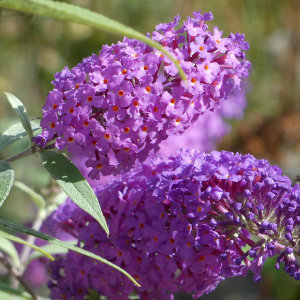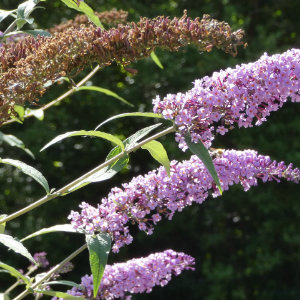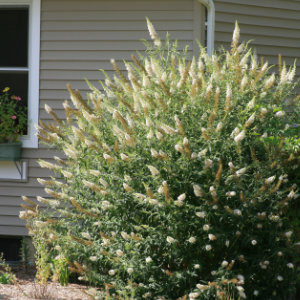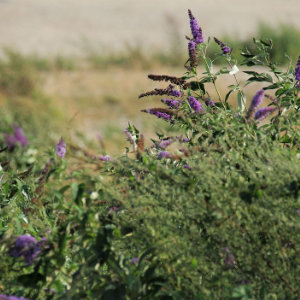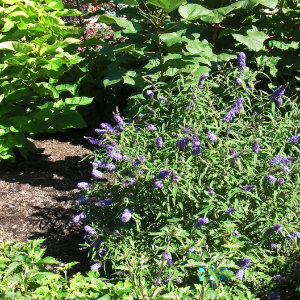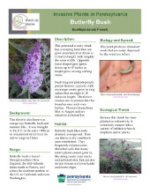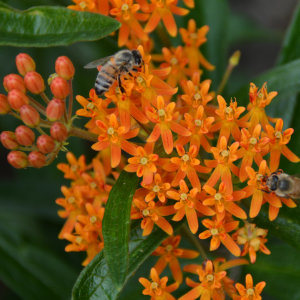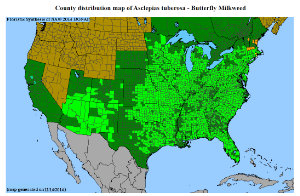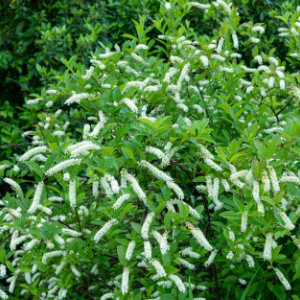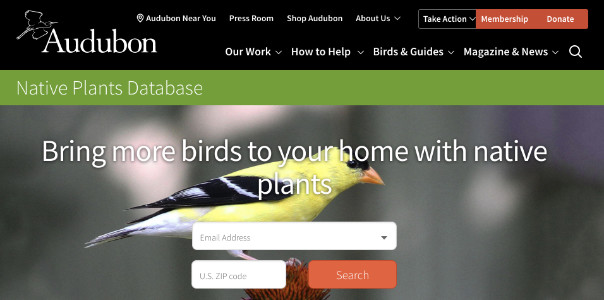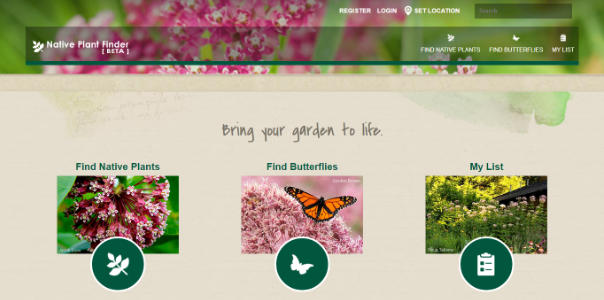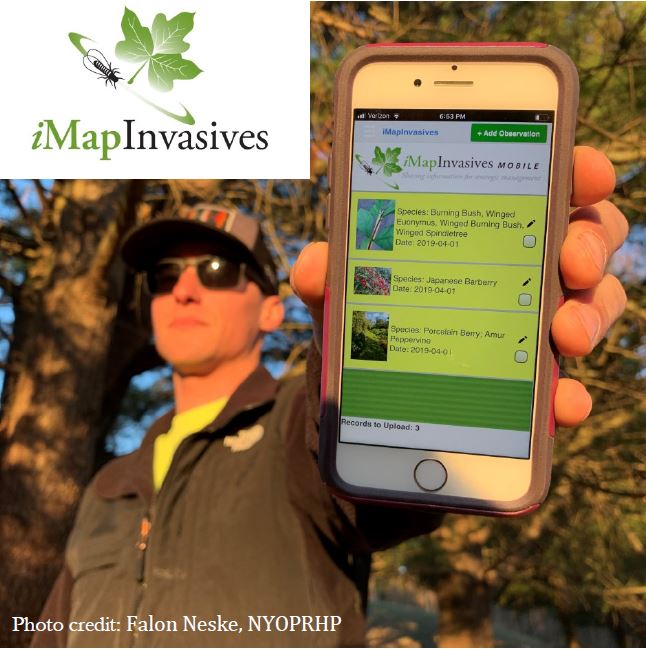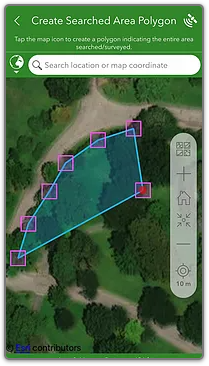Orange-Eye Butterfly-Bush
With its eye-catching flowers, gardeners love planting orange-eye butterfly-bush (Buddleja davidii) to attract butterflies to their home landscapes. While the plant brings butterflies to the flowers, it does not provide food for caterpillars. Planting native plants are hosts for caterpillars and nectar sources for adult butterflies benefits all life stages of these important pollinators.
- Credit: Linda De Volder, Buddleja davidii, CC BY-NC-ND 2.0
- Credit: Linda De Volder, “Buddleja davidii”, CC BY-NC-ND 2.0
- Credit: John Brandauer, “Butterfly Bush (Buddleja davidii) ‘White Profusion’ 2”, CC BY-NC-ND 2.0
Identification

Credit: Peter O’Connor aka anemoneprojectors, “Butterfly-bush (Buddleja davidii) flowers”, CC BY-SA 2.0
Orange-eye butterfly-bush is a multi-stemmed shrub, usually 6-12 feet in height and can spread 4-15 feet. The plant forms four petal flowers in a corolla tube. Naturalized butterfly-bush flowers are commonly lilac and purple in color, but cultivars can be white, yellow, and red. Flowers grow on 8-18 spikes that have an orange nectar guide in the center. Butterfly-bush has a toothed-edged simple leaf which is paired at each node on the stem. In natural settings, this plant can be found growing in disturbed habitats, forest edges, forests, and stream corridors.
Orange-eye butterfly-bush is unlikely to be confused with other plants.
Additional information on how to identify orange-eye butterfly-bush can be found online.
Ecological Threat
The aggressively growing orange-eye butterfly-bush is not as beneficial to butterflies as its name implies. The plant is known for escaping from gardens and into natural areas, though there are some newer varieties that produce very little seed which discourage the plant’s spread to new locations.
While butterfly bush does provide nectar to butterflies and other pollinating insects, it offers no value for butterfly or moth larvae. According to entomologist Doug Tallamy in his book “Bringing Nature Home”, not a single native North American caterpillar will feed on its leaves.
Because butterflies rely on native plants to complete their life cycle, caterpillars feed on their native host plants by consuming plant leaves. In areas where orange-eye butterfly-bush becomes dominant, this non-native invasive plant may exclude butterfly host plants to the detriment of the next generation of butterflies.
Control and Removal
If orange-eye butterfly-bush is present on your property, consider removal and management options. The following resource provides valuable information and tips.
Other management tips can be found at:
Plant Native Alternatives
*This list is not comprehensive, but rather provides a sampling of species available for purchase from retailers located in Pennsylvania and/or surrounding states. All native plant distribution maps (below) are provided by the Biota of North America Program.
- Credit: Michele Dorsey Walfred, “Orange butterfly weed Asclepias tuberosa,”, CC BY 2.0
Butterfly Milkweed (Asclepias tuberosa)
Butterfly milkweed is easily grown in dry to medium, well drained soils. It prefers areas that get full sun and is drought tolerant.
- Credit: Puddin Tain, “Virginia Sweetspire 1 NBG”, CC BY-SA 2.0
Virginia Sweetspire (Itea virginica)
Virginia sweetspire is easily grown in average, medium to wet, well-drained soils. It prefers to be in areas that receive full sun to part shade. Consider using this plant in a rain garden.
- Credit: John Brandauer, “New York Ironweed (Vernonia noveboracensis)”, CC BY-NC-ND 2.0
New York Ironweed (Vernonia noveboracensis)
New York ironweed can be grown in a variety of soil types, but prefers rich, moist, and slightly acidic soils. It grows well in areas that receive full sun.
Learn More and Take Action
Why are Native Plants Important?
Learn more about the importance of planting native plants by reviewing the following resources. And remember, planting even one native plant on your property is a tremendous benefit to wildlife and the environment!
Doug Tallamy Explains, “Why Native Plants?”
Credit: Catherine Zimmerman
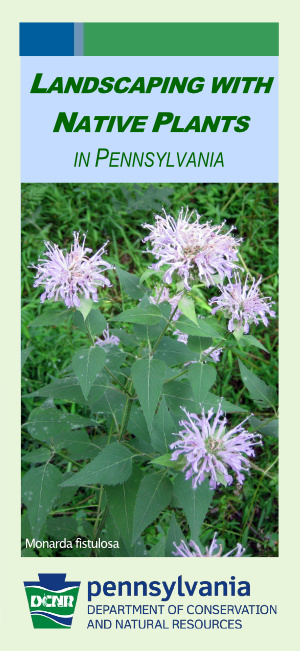
Landscaping with Native Plants in Pennsylvania
Credit: PA Department of Conservation and Natural Resources
Professor Doug Tallamy on Sustainable Landscaping
Credit: University of Delaware
Discover Native Plants.
Learn what plants are native to your area by using the National Wildlife Federation’s Native Plant Finder or the Audubon’s Native Plants Database. Both programs are easy to use - just type in your zip code and a list of native plants is provided to you.
Record Invasive Species Findings with iMapInvasives.
If you find invasive plants and animals in natural areas such as parks, forests, and meadows, please report them to iMapInvasives, an online tool used by natural resource professionals and citizen scientists to record locations of invasive species The iMapInvasives program is useful in understanding species distributions statewide and is used by land managers to prioritize locations to conduct treatment efforts. In Pennsylvania, the iMapInvasives program is administered by the Western Pennsylvania Conservancy and the Pennsylvania Natural Heritage Program and is financially supported by the Great Lakes Restoration Initiative. At the national level, iMapInvasives is administered by NatureServe.
A free registered user account is needed in order to contribute and view data in iMapInvasives. Register here.
How to create a presence record in iMapInvasives online (video)
Connect with Our Experts
Please direct any questions or comments regarding this species profile to Amy Jewitt, Invasive Species Coordinator, or Mary Walsh, Aquatic Zoology Coordinator.

